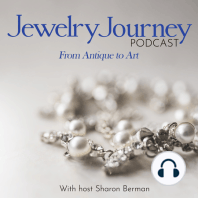17 min listen

Episode 169 Part 2: How Four Winds Gallery Brought Native American Jewelry to Australia
Episode 169 Part 2: How Four Winds Gallery Brought Native American Jewelry to Australia
ratings:
Length:
25 minutes
Released:
Sep 8, 2022
Format:
Podcast episode
Description
What you’ll learn in this episode: Why Native American jewelry has struck a chord with Australian shoppers Why jewelry is so important to Native American cultures, and the history of jewelry making in the Southwest Which characteristics to look for in distinct varieties of turquoise How to make the most of a trip to Indian Market Which Native American jewelry artists are ones to watch About Jennifer Cullen Jennifer Cullen is the owner of Four Winds Gallery, a jewelry gallery in Double Bay, Australia that focuses on jewelry of the American Southwest. Established in 1981, Four Winds boasts a collector’s standard of traditional and contemporary North American Indian jewelry, pottery, sculptures, graphics and textiles. The gallery is the culmination of a long-term interest and passion for Jennifer. Photos available on TheJewelryJourney.com Additional Resources: Website Instagram Facebook Transcript: Sharon: Hello, everyone. Welcome to the Jewelry Journey Podcast. This is the second part of a two-part episode. If you haven’t heard part one, please go to TheJewelryJourney.com. Today, my guest is Jennifer Cullen of Four Winds Gallery, an unusual jewelry gallery located in Double Bay, Australia. Welcome back. What about coral? You have the reefs there, and there’s a lot of coral in Indian work, but I hear it’s becoming very hard to find now. Jennifer: We have no coral in Australia to work with. It’s protected, and we have a lot of trouble with—what is it? The crown-of-thorns starfish. They’re doing a lot about coral beds on the northeast coast of Australia, with all that big, beautiful coral. They’re doing a lot to maintain that at the moment. All the coal that has been historically worked into North American Indian jewelry was traded in by the Spanish originally, so it’s all Mediterranean coral. The earliest coral strands in the 1800s were drilled and rolled strands of beads that they would wear around the neck with cotton sinew or twill, or whatever was strung through the center of it. And there were webs of coral. They would wear ropes of heishi done in clamshell. Later on, as they got better equipment, there was turquoise heishi and jet heishi. Heishi is the traditional word for a handmade, small bead. Originally the coral was traded. The Native American groups loved the color. They had previously found their ability with color by working with the spiny oyster shell that comes out of the Gulf of Mexico. The spiny oyster shell comes in colors from reds similar to coral into purple and intense orange, like an Hermès orange. It’s a beautiful color. I actually have a lot in my jewelry because I love it. I sell a lot of it here, and I wear a lot of it. I love the orange. I’ve always had a passion for these oranges and reds and purples. People in the Southwest embraced it pretty rapidly and started to incorporate it into their jewelry findings and body adornment. So, in the 1800s, it was works of coral predominantly. Then they started to learn how to work silver. That didn’t start until about 1868. Prior to 1868, there was very little in silver. They actually started by heating up copper and brass cooking utensils. They were soft materials that were exposed to them by the soldiers and the Spanish and the Mexicans, and they’d make it into jewelry findings and body adornment. Then they discovered silver, which is found in the Southwest of the USA, and they started to make that into metal findings to house the stones. That was the process. When chatting at length with another one of my mentors, Lori Phillips, she used to talk to me a lot about the development of American Indian jewelry, history and development. She was a big dealer and collected from Pasadena in California back in the day. I was very close friends with her. Anyway, she taught me a lot. They started setting coral into silver vessels and housings and cabinets in about the early 1950s. There wasn’t a lot of coral set into jewelry, other than strands or rop
Released:
Sep 8, 2022
Format:
Podcast episode
Titles in the series (100)
Episode 1: The Importance of Antique & Estate Jewelry Today with Jewelry Appraiser Edward Lewand: Edward A. Lewand, GG, ASA, AAA, is a professional, independent appraiser of fine and antique jewelry. He works with attorneys on estates, trusts, insurance matters and copyright issues; appraisal theories and concepts; and matrimonial appraising.... by Jewelry Journey Podcast